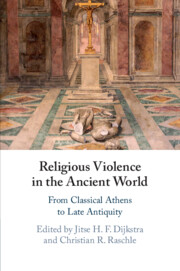Book contents
- Religious Violence in the Ancient World
- Religious Violence in the Ancient World
- Copyright page
- Contents
- Acknowledgements
- List of Contributors
- A Note on Abbreviations
- General Introduction
- Part I Methodology
- Part II Religious Violence in the Graeco-Roman World
- Part III Religious Violence in Late Antiquity
- Chapter 10 Religious Violence in Late Antiquity: Current Approaches, Trends and Issues
- Chapter 11 Coercion in Late Antiquity: A Brief Intellectual History
- Chapter 12 Crowd Behaviour and the Destruction of the Serapeum at Alexandria in 391/392 ce
- Chapter 13 Violence and Monks: From a Mystical Concept to an Intolerant Practice (Fourth to Fifth Century)
- Chapter 14 The Discipline of Domination: Asceticism, Violence and Monastic Curses in Theodoret’s Historia Religiosa
- Chapter 15 Suffering Saints: Shaping Narratives of Violence after Chalcedon
- Chapter 16 Fighting for Chalcedon: Vitalian’s Rebellion against Anastasius
- Chapter 17 The Emperor, the People and Urban Violence in the Fifth and Sixth Centuries
- Index of Sources
- General Index
Chapter 17 - The Emperor, the People and Urban Violence in the Fifth and Sixth Centuries
from Part III - Religious Violence in Late Antiquity
Published online by Cambridge University Press: 18 September 2020
- Religious Violence in the Ancient World
- Religious Violence in the Ancient World
- Copyright page
- Contents
- Acknowledgements
- List of Contributors
- A Note on Abbreviations
- General Introduction
- Part I Methodology
- Part II Religious Violence in the Graeco-Roman World
- Part III Religious Violence in Late Antiquity
- Chapter 10 Religious Violence in Late Antiquity: Current Approaches, Trends and Issues
- Chapter 11 Coercion in Late Antiquity: A Brief Intellectual History
- Chapter 12 Crowd Behaviour and the Destruction of the Serapeum at Alexandria in 391/392 ce
- Chapter 13 Violence and Monks: From a Mystical Concept to an Intolerant Practice (Fourth to Fifth Century)
- Chapter 14 The Discipline of Domination: Asceticism, Violence and Monastic Curses in Theodoret’s Historia Religiosa
- Chapter 15 Suffering Saints: Shaping Narratives of Violence after Chalcedon
- Chapter 16 Fighting for Chalcedon: Vitalian’s Rebellion against Anastasius
- Chapter 17 The Emperor, the People and Urban Violence in the Fifth and Sixth Centuries
- Index of Sources
- General Index
Summary
There are many reasons for returning to a field in which I was involved twenty years ago, when I brought out a detailed analysis of the Nika riot. Given the theme of this volume, however, it would be of little relevance to focus too narrowly on the events of January 532.1 Instead, I propose to examine at a more general level the dynamics of riots in the fifth and sixth centuries, seeking in particular to discern what factors were involved, and more particularly to what extent religious or doctrinal loyalties played a part, and what the consequences of the developments over this period were. I shall start with a brief survey of how approaches to factions and violence have changed in recent scholarship; one of the key themes here will be the blurring of lines between factional and religious violence, as scholars have underlined the numerous common traits of factions and the Church, both of which constituted powerful empire-wide organisations with their own objectives and interests.2
- Type
- Chapter
- Information
- Religious Violence in the Ancient WorldFrom Classical Athens to Late Antiquity, pp. 389 - 405Publisher: Cambridge University PressPrint publication year: 2020

